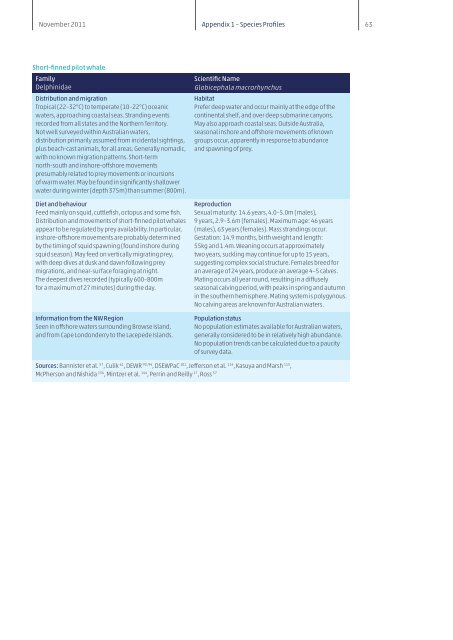Australia's last great whale haven.pdf - Ningaloo Atlas
Australia's last great whale haven.pdf - Ningaloo Atlas
Australia's last great whale haven.pdf - Ningaloo Atlas
- TAGS
- whale
- ningaloo
- atlas
- www.ifaw.org
You also want an ePaper? Increase the reach of your titles
YUMPU automatically turns print PDFs into web optimized ePapers that Google loves.
November 2011 Appendix 1 – Species Profiles<br />
63<br />
Short-finned pilot <strong>whale</strong><br />
Family<br />
Delphinidae<br />
Distribution and migration<br />
Tropical (22–32°C) to temperate (10–22°C) oceanic<br />
waters, approaching coastal seas. Stranding events<br />
recorded from all states and the Northern Territory.<br />
Not well surveyed within Australian waters,<br />
distribution primarily assumed from incidental sightings,<br />
plus beach-cast animals, for all areas. Generally nomadic,<br />
with no known migration patterns. Short-term<br />
north-south and inshore-offshore movements<br />
presumably related to prey movements or incursions<br />
of warm water. May be found in significantly shallower<br />
water during winter (depth 375m) than summer (800m).<br />
Diet and behaviour<br />
Feed mainly on squid, cuttlefish, octopus and some fish.<br />
Distribution and movements of short-finned pilot <strong>whale</strong>s<br />
appear to be regulated by prey availability. In particular,<br />
inshore-offshore movements are probably determined<br />
by the timing of squid spawning (found inshore during<br />
squid season). May feed on vertically migrating prey,<br />
with deep dives at dusk and dawn following prey<br />
migrations, and near-surface foraging at night.<br />
The deepest dives recorded (typically 600–800m<br />
for a maximum of 27 minutes) during the day.<br />
Information from the NW Region<br />
Seen in offshore waters surrounding Browse Island,<br />
and from Cape Londonderry to the Lacepede Islands.<br />
Scientific Name<br />
Globicephala macrorhynchus<br />
Habitat<br />
Prefer deep water and occur mainly at the edge of the<br />
continental shelf, and over deep submarine canyons.<br />
May also approach coastal seas. Outside Australia,<br />
seasonal inshore and offshore movements of known<br />
groups occur, apparently in response to abundance<br />
and spawning of prey.<br />
Reproduction<br />
Sexual maturity: 14.6 years, 4.0–5.0m (males),<br />
9 years, 2.9–3.6m (females). Maximum age: 46 years<br />
(males), 63 years (females). Mass strandings occur.<br />
Gestation: 14.9 months, birth weight and length:<br />
55kg and 1.4m. Weaning occurs at approximately<br />
two years, suckling may continue for up to 15 years,<br />
suggesting complex social structure. Females breed for<br />
an average of 24 years, produce an average 4–5 calves.<br />
Mating occurs all year round, resulting in a diffusely<br />
seasonal calving period, with peaks in spring and autumn<br />
in the southern hemisphere. Mating system is polygynous.<br />
No calving areas are known for Australian waters.<br />
Population status<br />
No population estimates available for Australian waters,<br />
generally considered to be in relatively high abundance.<br />
No population trends can be calculated due to a paucity<br />
of survey data.<br />
Sources: Bannister et al. 57 , Culik 61 , DEWR 93, 94 , DSEWPaC 101 , Jefferson et al. 114 , Kasuya and Marsh 115 ,<br />
McPherson and Nishida 134 , Mintzer et al. 144 , Perrin and Reilly 17 , Ross 57

















